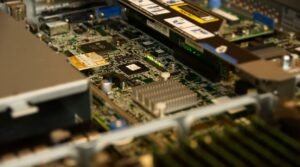AI vs ML
Artificial Intelligence (AI) and Machine Learning (ML) are two buzzwords that are often used interchangeably, but they are not the same thing. Understanding the difference between AI and ML is important, as they have distinct characteristics and applications.
Key Takeaways:
- AI refers to the broader concept of machines carrying out tasks in a way that mimics human intelligence.
- ML is a subset of AI that focuses on systems that learn and improve from experience without being explicitly programmed.
- AI can be applied in various fields, including healthcare, finance, and transportation.
- ML algorithms are used to train models that can make predictions or take actions based on patterns in data.
While AI is more of a general term encompassing various technologies, ML is a specific approach to achieving AI by leveraging data and algorithms. AI seeks to make machines act and behave like humans, while ML focuses on enabling machines to learn and improve from experience. To better understand the difference, let’s dive deeper into each concept.
Artificial Intelligence (AI)
Artificial Intelligence is a multidisciplinary field that aims to create systems capable of performing tasks that would typically require human intelligence. These tasks can range from speech recognition and natural language processing to decision-making and problem-solving. AI can be classified into two categories: narrow AI and general AI.
Narrow AI is designed to perform specific tasks and operates within a defined scope, while general AI aims to exhibit human-like intelligence across multiple domains and perform any intellectual task that a human can do.
Machine Learning (ML)
Machine Learning is a subset of AI that focuses on developing algorithms and techniques that enable machines to learn from data and improve their performance without being explicitly programmed. ML algorithms analyze large datasets to discover patterns, relationships, and trends, which they use to make predictions or take actions.
One interesting aspect of ML is that models can be trained using labeled data (supervised learning), where inputs and outputs are provided, or unlabeled data (unsupervised learning), where the system learns from the data patterns and structures itself.
AI vs ML: A Comparison
| AI | ML |
|---|---|
| Encompasses a wide range of technologies and approaches. | Focuses on training models to learn from data. |
| Plays a role in decision-making, problem-solving, and mimicking human behavior. | Used for making predictions, identifying patterns, and automating tasks. |
| Can operate with or without large datasets. | Relies on large datasets to identify patterns and make accurate predictions. |
It’s important to note that ML is a subset of AI, meaning all ML is AI, but not all AI is ML. ML is the method or approach used to achieve AI in certain applications.
Applications of AI and ML
Both AI and ML have a wide range of practical applications across various industries. Here are some notable examples:
- AI in healthcare: AI-powered systems can assist in diagnosing diseases, analyzing medical images, and predicting patient outcomes based on medical records.
- ML in finance: ML algorithms are used for credit scoring, fraud detection, algorithmic trading, and portfolio optimization.
- AI in transportation: Self-driving cars utilize AI technologies to perceive the environment, make decisions, and navigate safely.
Conclusion
Artificial Intelligence and Machine Learning are two interconnected fields that have significant implications for various industries. AI aims to replicate human intelligence, while ML focuses on developing algorithms that enable machines to learn and improve from data. Understanding their differences and applications is crucial in harnessing their potential and driving innovation.

Common Misconceptions
AI and ML are the same thing
One of the common misconceptions people have is that Artificial Intelligence (AI) and Machine Learning (ML) are interchangeable terms. While AI is a broader concept that involves creating machines that can perform tasks requiring human intelligence, ML is a subset of AI that focuses on training algorithms to learn patterns and make predictions based on data.
- AI encompasses a wider range of technologies, including ML.
- ML is a specific AI technique that enables machines to learn from data.
- AI can exist without ML, but ML relies on AI to function effectively.
AI and ML will replace human jobs
Another misconception is the fear that AI and ML will completely replace human jobs. While these technologies can automate certain repetitive or mundane tasks, they are more likely to augment human capabilities rather than replace them entirely. AI and ML serve to enhance human performance and productivity by handling repetitive tasks, processing vast amounts of data, and providing valuable insights.
- AI and ML can improve efficiency and accuracy in various industries.
- Humans will still be needed for decision-making, creativity, and critical thinking.
- New job roles and opportunities can be created as a result of AI and ML advancements.
AI and ML are only for high-tech industries
Many people believe that AI and ML are only applicable to high-tech industries such as software development or robotics. This misconception overlooks the fact that AI and ML can be beneficial across a wide range of sectors, including healthcare, finance, marketing, transportation, and agriculture.
- AI and ML can improve patient diagnosis and treatment in healthcare.
- In finance, ML algorithms can detect fraudulent transactions and predict market trends.
- AI-powered chatbots can enhance customer support in various industries.
AI and ML always make accurate decisions
There is a misconception that AI and ML algorithms always make accurate decisions and predictions. However, these technologies are only as good as the data they are trained on and the algorithms being used. Biased or incomplete data, improper model training, and algorithmic limitations can lead to erroneous outcomes and decisions.
- Data quality and diversity are crucial for accurate AI and ML outcomes.
- Regular monitoring and updating of AI and ML models are necessary to avoid biases and errors.
- Human intervention and oversight are important to validate and correct decisions made by AI and ML systems.
AI and ML are far-off futuristic technologies
Finally, many people consider AI and ML to be far-off futuristic technologies that are not yet relevant in our daily lives. However, AI and ML have already integrated into our lives in various ways. Intelligent virtual assistants like Siri or Alexa, personalized product recommendations, and face recognition technologies are just a few examples that demonstrate their presence in our current reality.
- AI and ML technologies are already transforming several industries and business processes.
- Smart home devices and autonomous vehicles are practical implementations of AI and ML.
- AI and ML will continue to advance and become more pervasive in our daily lives.

Introduction
In the era of technological advancements, the realms of Artificial Intelligence (AI) and Machine Learning (ML) have gained immense popularity. Both AI and ML are reshaping our world, but they differ in their approach. AI encompasses the broader concept of machines displaying human-like intelligence, while ML focuses on training machines to learn from data. This article explores various aspects of AI and ML, highlighting their differences and illustrating their effect on different industries. The following tables present interesting data and comparisons relevant to this topic.
AI and ML Adoption by Industries
The table below showcases the widespread adoption of AI and ML technologies in different industries, indicating the percentage of companies in each sector that have incorporated these technologies into their processes.
| Industry | Percentage of Companies |
|---|---|
| Healthcare | 72% |
| Finance | 68% |
| Retail | 65% |
| Manufacturing | 57% |
| Transportation | 48% |
AI vs. ML: Computing Power Requirements
This table presents a comparison of the computing power requirements for AI and ML applications, highlighting the significant difference between the two technologies.
| Technology | Computing Power Requirements |
|---|---|
| AI | High computational power |
| ML | Relatively lower computational power |
AI and ML: Job Creation Potential
The table below demonstrates the potential job creation impact of AI and ML technologies, including the number of jobs predicted to be created by these fields in the next five years.
| Technology | Estimated Job Creation (Next 5 Years) |
|---|---|
| AI | 2.3 million jobs |
| ML | 1.7 million jobs |
AI vs. ML: Ethical Considerations
This table highlights the ethical considerations associated with AI and ML technologies, shedding light on the potential benefits and risks they pose to society.
| Consideration | AI | ML |
|---|---|---|
| Benefits | Improved diagnosis accuracy in healthcare | Efficient fraud detection in finance |
| Risks | Potential job displacement | Data bias in decision-making |
AI and ML: Algorithm Versatility
The table below emphasizes the versatility of AI and ML algorithms by showcasing the various areas where they are widely applied.
| Algorithm | Application |
|---|---|
| Neural Networks | Image recognition, natural language processing |
| Decision Trees | Medical diagnosis, customer segmentation |
| Support Vector Machines | Fraud detection, stock market analysis |
| Reinforcement Learning | Robotics, game playing |
| Random Forests | Ecological modeling, credit risk analysis |
AI vs. ML: Time to Train Models
The table below compares the time required to train AI and ML models, illustrating the complexity and duration of each process.
| Model | Time to Train |
|---|---|
| AI Model | Several weeks to months |
| ML Model | Hours to days |
AI and ML: Impact on Education
This table portrays the impact of AI and ML technologies on education, showcasing the different ways they enhance the learning experience.
| Impact Area | AI | ML |
|---|---|---|
| Personalized Learning | Adapts content based on learner’s progress | Customizes assessments for individual students |
| Educational Research | Enables data-driven analysis of learning outcomes | Identifies patterns to improve teaching methods |
| Virtual Assistants | Provides virtual tutors for additional support | Assists in automated grading |
AI vs. ML: Limitations
The following table highlights the limitations inherent in AI and ML technologies.
| Limitations | AI | ML |
|---|---|---|
| Data Dependency | Requires vast amounts of training data | Relies on quality and representative data |
| Explanation Difficulties | Can be challenging to explain decision-making processes | Black-box problem: Difficult to interpret outcomes |
| Context Awareness | Struggles when confronted with ambiguous situations | Limited in understanding nuanced contexts |
AI and ML: Use in Customer Service
The table below showcases how AI and ML are revolutionizing customer service, highlighting the benefits of automation and personalized interactions.
| Application | AI | ML |
|---|---|---|
| Chatbots | Provides instant responses to queries | Improves responses over time through learning |
| Recommendation Systems | Suggests personalized products or services | Refines recommendations based on user behavior |
| Sentiment Analysis | Identifies customer emotions for improved interactions | Analyzes feedback to enhance customer experience |
Conclusion
In conclusion, AI and ML have become integral parts of our lives, transforming various industries and offering unique advantages. The tables presented above provide insights into the adoption of AI and ML, their ethical considerations, algorithm versatility, job creation potential, computing power requirements, and more. As both technologies continue to advance, a balance between their benefits and limitations is crucial to ensure the responsible and effective utilization of AI and ML in the future.
Frequently Asked Questions
FAQ 1: What is Artificial Intelligence (AI)?
AI refers to the simulation of human intelligence in machines that are programmed to think and learn like humans. It encompasses various technologies, algorithms, and frameworks that enable machines to mimic human cognitive processes.
FAQ 2: How is Machine Learning (ML) different from AI?
Machine Learning is a subset of AI that focuses on developing algorithms and models that allow machines to learn and make predictions without explicit programming. AI, on the other hand, encompasses a wider range of technologies beyond just machine learning.
FAQ 3: What are the key components of Artificial Intelligence?
The key components of AI include natural language processing (NLP), computer vision, expert systems, robotics, and machine learning. These components work together to enable machines to perform various tasks that require human-like intelligence.
FAQ 4: How does Machine Learning work?
Machine Learning algorithms work by training the machine on a dataset and then making predictions or taking actions based on the patterns and trends identified in the data. The machine learns from the data and adapts its behavior accordingly.
FAQ 5: Which industries are benefitting from AI and ML?
AI and ML have a wide range of applications across various industries. Some of the industries that are benefitting from AI and ML include healthcare, finance, e-commerce, manufacturing, transportation, and entertainment, among others.
FAQ 6: Can AI and ML replace human jobs?
AI and ML have the potential to automate certain tasks and replace some jobs. However, they also have the ability to augment human capabilities and create new opportunities. It is more likely that AI and ML will complement human workers rather than replace them entirely.
FAQ 7: Are AI and ML the same as human intelligence?
No, AI and ML are not the same as human intelligence. While they can mimic some aspects of human intelligence, they lack the consciousness, creativity, and emotional understanding that humans possess.
FAQ 8: What are the ethical considerations of AI and ML?
AI and ML raise ethical considerations such as privacy concerns, bias in algorithms, and potential job displacement. It is important to ensure that AI and ML systems are developed and used responsibly to minimize these ethical challenges.
FAQ 9: How can AI and ML improve the healthcare industry?
AI and ML can improve the healthcare industry by enhancing diagnostics, predicting outcomes, optimizing treatment plans, and improving patient care. They can analyze large volumes of medical data and provide valuable insights to healthcare professionals.
FAQ 10: What is the future of AI and ML?
The future of AI and ML holds tremendous potential for advancements in various fields. We can expect to see further integration of AI and ML technologies in industries, improved automation, smarter personal devices, and continued research and innovation in the field.




